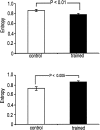Separate encoding of identity and similarity of complex familiar odors in piriform cortex
- PMID: 17005727
- PMCID: PMC1622801
- DOI: 10.1073/pnas.0604313103
Separate encoding of identity and similarity of complex familiar odors in piriform cortex
Abstract
Piriform cortical circuits are hypothesized to form perceptions from responses to specific odorant features, but the anterior piriform cortex (aPCX) and posterior piriform cortex (pPCX) differ markedly in their anatomical organization, differences that could lead to distinct roles in odor encoding. Here, we tested whether experience with a complex odorant mixture would modify encoding of the mixture and its components in aPCX and pPCX. Rats were exposed to an odorant mixture and its components in a go/no-go rewarded odor discrimination task. After reaching behavioral performance criterion, single-unit recordings were made from the aPCX and pPCX in these rats and in odor-naïve, control, urethane-anesthetized rats. After odor experience, aPCX neurons were more narrowly tuned to the test odorants, and there was a decorrelation in aPCX population responses to the mixture and its components, suggesting a more distinct encoding of the familiar mixture from its components. In contrast, pPCX neurons were more broadly tuned to the familiar odorants, and pPCX population responses to the mixture and its components became more highly correlated, suggesting a pPCX encoding of similarity between familiar stimuli. The results suggest aPCX and pPCX play different roles in the processing of familiar odors and are consistent with an experience-dependent encoding (perceptual learning) of synthetic odorant identity in aPCX and an experience-dependent encoding of odor similarity or odor quality in pPCX.
Conflict of interest statement
The authors declare no conflict of interest.
Figures




Comment in
-
Functional units in the olfactory system.Proc Natl Acad Sci U S A. 2006 Oct 10;103(41):14985-6. doi: 10.1073/pnas.0607416103. Epub 2006 Oct 2. Proc Natl Acad Sci U S A. 2006. PMID: 17015819 Free PMC article. Review. No abstract available.
Similar articles
-
Rapid, experience-induced enhancement in odorant discrimination by anterior piriform cortex neurons.J Neurophysiol. 2003 Jul;90(1):65-72. doi: 10.1152/jn.00133.2003. Epub 2003 Mar 26. J Neurophysiol. 2003. PMID: 12660351
-
Cortical processing of configurally perceived odor mixtures.Brain Res. 2020 Feb 15;1729:146617. doi: 10.1016/j.brainres.2019.146617. Epub 2019 Dec 19. Brain Res. 2020. PMID: 31866364 Free PMC article.
-
Olfactory cortical adaptation facilitates detection of odors against background.J Neurophysiol. 2006 Mar;95(3):1888-96. doi: 10.1152/jn.00812.2005. Epub 2005 Oct 26. J Neurophysiol. 2006. PMID: 16251260 Free PMC article.
-
Receptive fields in the rat piriform cortex.Chem Senses. 2001 Jun;26(5):577-84. doi: 10.1093/chemse/26.5.577. Chem Senses. 2001. PMID: 11418503 Review.
-
Acetylcholine and olfactory perceptual learning.Learn Mem. 2004 Jan-Feb;11(1):28-34. doi: 10.1101/lm.66404. Learn Mem. 2004. PMID: 14747514 Free PMC article. Review.
Cited by
-
Converging prefrontal pathways support associative and perceptual features of conditioned stimuli.Nat Commun. 2016 May 4;7:11546. doi: 10.1038/ncomms11546. Nat Commun. 2016. PMID: 27143299 Free PMC article.
-
Orchestration of Hippocampal Information Encoding by the Piriform Cortex.Cereb Cortex. 2020 Jan 10;30(1):135-147. doi: 10.1093/cercor/bhz077. Cereb Cortex. 2020. PMID: 31220213 Free PMC article.
-
The perception of odor objects in everyday life: a review on the processing of odor mixtures.Front Psychol. 2014 Jun 2;5:504. doi: 10.3389/fpsyg.2014.00504. eCollection 2014. Front Psychol. 2014. PMID: 24917831 Free PMC article. Review.
-
Odor quality coding and categorization in human posterior piriform cortex.Nat Neurosci. 2009 Jul;12(7):932-8. doi: 10.1038/nn.2324. Epub 2009 May 31. Nat Neurosci. 2009. PMID: 19483688 Free PMC article.
-
Parallel odor processing by two anatomically distinct olfactory bulb target structures.PLoS One. 2012;7(4):e34926. doi: 10.1371/journal.pone.0034926. Epub 2012 Apr 4. PLoS One. 2012. PMID: 22496877 Free PMC article.
References
Publication types
MeSH terms
Grants and funding
LinkOut - more resources
Full Text Sources
Other Literature Sources

